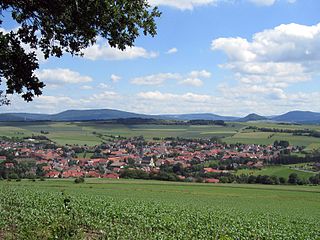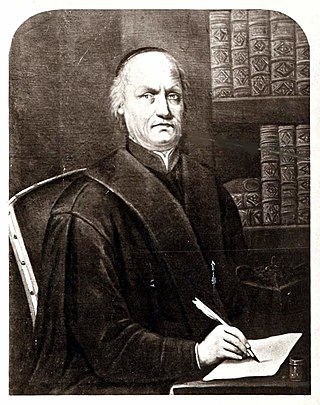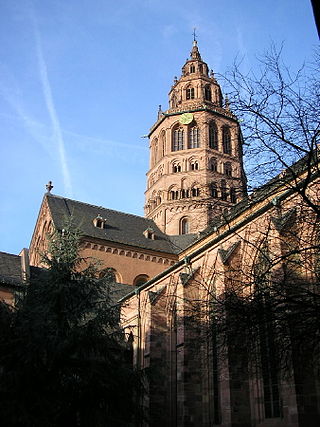Year 801 (DCCCI) was a common year starting on Friday of the Julian calendar, the 801st year of the Common Era (CE) and Anno Domini (AD) designations, the 801st year of the 1st millennium, the 1st year of the 9th century, and the 2nd year of the 800s decade.

Fulda is a city in Hesse, Germany; it is located on the river Fulda and is the administrative seat of the Fulda district (Kreis). In 1990, the city hosted the 30th Hessentag state festival.

Rabanus Maurus Magnentius, also known as Hrabanus or Rhabanus, was a Frankish Benedictine monk, theologian, poet, encyclopedist and military writer who became archbishop of Mainz in East Francia. He was the author of the encyclopaedia De rerum naturis. He also wrote treatises on education and grammar and commentaries on the Bible. He was one of the most prominent teachers and writers of the Carolingian age, and was called "Praeceptor Germaniae", or "the teacher of Germany". In the most recent edition of the Roman Martyrology, his feast is given as 4 February and he is qualified as a Saint ('sanctus').

Walafrid, alternatively spelt Walahfrid, nicknamed Strabo, was an Alemannic Benedictine monk and theological writer who lived on Reichenau Island in southern Germany.

Rasdorf is a municipality in the district of Fulda, in Hesse, Germany.

Hersfeld Abbey was an important Benedictine imperial abbey in the town of Bad Hersfeld in Hesse, Germany, at the confluence of the rivers Geisa, Haune and Fulda. The ruins are now a medieval festival venue.
Josef Magnus Wehner was a German writer and playwright. Celebrated as a "great German poet" his reputation is criticized for the militarism displayed in his work and his allegiance to the NSDAP.
Haymo was a German Benedictine monk who served as bishop of Halberstadt, and was a noted author.
Candidus (Bruun) of Fulda was a Benedictine scholar of the ninth-century Carolingian Renaissance, a student of Einhard, and author of the vita of his abbot at Fulda, Eigil.
Rudolf of Fulda was a Benedictine monk during the Carolingian period in the 9th century. Rudolf was active at Fulda Abbey in the present-day German state of Hesse. He was one of the most distinguished scholars of his time. Many of his works have been lost. However, his Annals of Fulda and Life of St. Leoba survive.
Hetto was the Archbishop of Trier from 814 until his death. In this capacity, he was both a political and ecclesiastical leader.

Christoph Brouwer was a Jesuit priest of the Netherlands, and ecclesiastical historian. He is particularly known for his contribution to the history of the Archdiocese of Trier.

The Diocese of Fulda is a Latin Church diocese of the Catholic Church in the north of the German state of Hessen. It is a suffragan diocese of the Archdiocese of Paderborn. The bishop's seat is in Fulda Cathedral.
Eigil was the fourth abbot of Fulda. He was the nephew and biographer of the abbey's founder and first abbot Saint Sturm. We know about Eigil primarily from the Latin Life that the monk and teacher of Fulda, Candidus Bruun composed about him after his death.

The Abbey of Fulda, from 1221 the Princely Abbey of Fulda and from 1752 the Prince-Bishopric of Fulda, was a Benedictine abbey and ecclesiastical principality centered on Fulda, in the present-day German state of Hesse.

The Rabanus-Maurus-Gymnasium is a classical gymnasium school in the Neustadt district of Mainz.
Ermanrich or Ermenrich was a Benedictine monk and court chaplain, who became Bishop of Passau from 866 to 874. He supported East Francia's expansion to the east, and likewise the expansion of the eastern bishoprics, and opposed the missionary efforts of Cyril and Methodius, who he considered intruders. This brought him into conflict with the Papacy, which supported the brother missionaries.
Hartmut von St. Gallen was abbot of the Abbey of Saint Gall.
Ferdinand Scherf, is a German professor and historian. From 1970 to 2007 he was a teacher at the Rabanus-Maurus-Gymnasium in Mainz and editor of local historical works.

The Free City of Mainz was a city-state that existed from 13 BC to 1803 in the early Middle Ages, which played a crucial role in the Christianization of the German and Slavic communities during the Middle Ages.
This page is based on this
Wikipedia article Text is available under the
CC BY-SA 4.0 license; additional terms may apply.
Images, videos and audio are available under their respective licenses.









